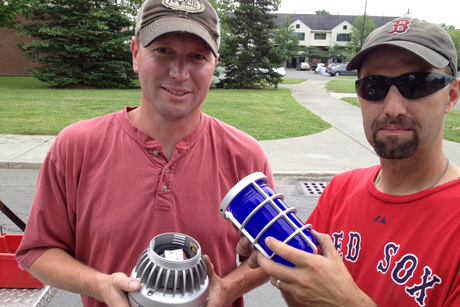Low-energy usage makes new 'blue lights' special
By Blaine Friedlander

On this campus boasting of red, you’ll see a slew of new blue lights that green the environment.
To further promote energy conservation, Cornell has been switching all of its approximately 120 campus-safety “blue lights” this summer from energy-hogging incandescent to a light-emitting diode (LED) technology, which sips power at one-tenth the rate.
With incandescent technology – as ancient as inventor Thomas Edison – the metal halide bulbs enjoyed a typical lifespan of two years at best, and the bulb usually dimmed significantly the second year. LED technology is brighter and can be seen in daylight. In addition the new lights are easier to maintain and have a 100,000-hour lifespan.
“The new fixtures are expected to last over 10 years before needing maintenance, and the light level will be nearly ‘new’ the whole time,” said Lanny Joyce, director of energy management in Facilities Services. “Being that these light fixtures provide a beacon to safety phones directly connected to Cornell Police for any campus emergency, the added visibility and reliability the LED provides – along with the huge reduction in electricity usage – are quite amazing.
Mark Howe, senior energy engineer, says the payback in energy costs is less than three years. The old 150-watt bulbs used 1,300 kilowatt hours each annually, at a cost of $100 per bulb per year. Systemwide, it cost the university about $12,500 in electricity. The new 15-watt LEDs have reduced energy usage by 90 percent, and now the energy cost will be $1,200 a year. Beyond energy savings, these blue lights get green in other ways, since they are mercury- and ultraviolet-free, and Restriction of Hazardous Substances compliant.
Campus blue lights indicate a special telephone directly connected to the Cornell Police. Find a blue light, and you’ll find a phone. If you are lost, having car problems, want to report a suspicious incident or a medical emergency, or for any other kind of assistance, lift the receiver or push the button.
The team working on the project includes: electric shop superintendent Jim O’Brien; assistant superintendent Heather Mulks; foreperson Nate Deeley; electricians Dave Pawelczyk and Jon Ryan; project engineer Brian Watson; Howe and Joyce.
Media Contact
Get Cornell news delivered right to your inbox.
Subscribe